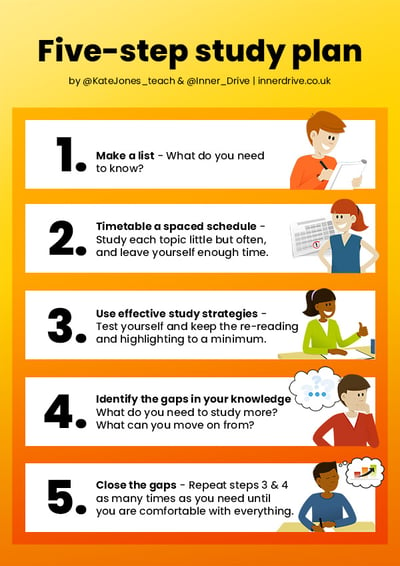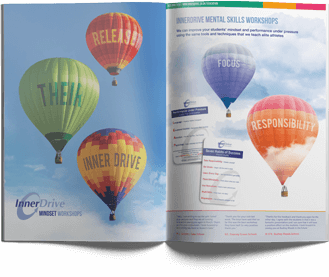The start of the academic year is the perfect time to start a conversation with your students about how effective study strategies can help them become independent learners. This is not to put pressure on students to revise but instead do the exact opposite: help with organisation and confidence.
Kate Jones has created the below five-step plan to share with your students to support their studies. It can be adapted across a range of subjects and used with learners of different ages.
 1. Make a list - what do you need to know?
1. Make a list - what do you need to know?
Exam classes will have detailed specifications provided by examination boards; this contains the content, concepts, terms and materials that students must know. This can be the base for a list to ensure the content studied focuses on the essential information that students need to know. Younger students can be provided with a “Knowledge Organiser” which contains a summary overview of key content and material to be learned.
Another piece of advice would be to break down a specification or knowledge organiser into units, topics or smaller sections. This will be more manageable and less overwhelming. Once students can recall information from memory with ease and confidence they can then cross it off their list.
2. Timetable a spaced schedule
Research has shown that spaced practice (distributed over time) is much more effective for long-term learning than massed practice (cramming). In some studies, using spacing instead of cramming resulted in a 10% to 30% difference in final test results. This finding has been found throughout a range of tasks, including remembering key words, random facts or solving maths problems.
Students often assume that cramming is more effective but it can in fact be more stressful as it involves intense and last-minute study, and only offers a short-term learning boost, with the knowledge forgotten soon after.
If students aren’t organised, then they will have no option other than to resort to cramming — hence why preparing early and planning a spacing schedule can be very helpful. This will enable students to do little and often regularly; but it is not easy to do this. Students need guidance and support, this can be with a calendar or homework schedule to support spaced practice. Spaced practice requires organisation and commitment from students but it is a strategy students should embrace.
3. Use effective, evidence-informed study strategies
Once students have the list of materials they need to revise and have a schedule to follow, they need to ensure that they use evidence-informed, effective study strategies. Popular and widely used study strategies such as re-reading, highlighting and underlining give students a false sense of confidence and often require a huge amount of time, effort and energy. Students might take the attitude that any revision is better than no revision — but not all revision techniques are made equal.
Students need to know the benefits of retrieval practice and spacing, and how to use them independently as part of their studies. Flash cards, self-quizzing and brain dumps (writing down as much information as possible from memory) are all efficient techniques students can use easily. Highlighters can be used at the start of the revision process, to identify key terms, facts, dates etc., but the key to successful study is using the highlighted information to self-test and quiz.
4. Identify gaps in knowledge
A key reason why retrieval practice is more effective than highlighting, re-reading and underlining is because it can explicitly show students the gaps in their knowledge. Methods of self-testing and -quizzing show the student what they can recall. Sometimes, they will recall information quickly and with ease, whereas other times they will find it challenging and slow, recall incorrect information, or be unable to recall anything at all.
Identifying gaps in knowledge is very powerful because it guides students' future study, showing what to focus on next (see next step) and what to move on from.
5. Close the gaps
Once students have identified gaps in their knowledge, it’s time to revisit the lesson materials they are not comfortable with yet. After doing so, they can then test themselves again on that content until they can recall that information correctly and confidently. Once they have achieved this, students can refer back to step 1 and work their way through their study list.
Thanks to Kate Jone, teacher and author of the Retrieval Practice books, for allowing us to use and write about her five-step study plan. Be sure to follow her on Twitter @KateJones_teach.







